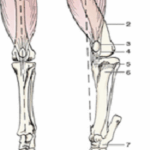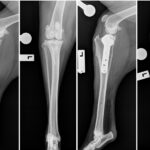
Lump in a dog’s skin
What is this lump?
I don’t know either. Even after 17 years of being a vet.
I recently saw a dog with two lumps. The dog was seen by another vet around 12-18 months ago and was told that the lumps were lipomas, which are benign, fatty lumps that we don’t need to worry about.
The dog came in to see me for a different problem, but when I noticed the lumps I asked the owner about them. It turns out the previous vet had just felt the lumps and made the diagnosis without taking a sample.
The problem with diagnosing these lumps without taking a sample is that you can’t diagnose these lumps without taking a sample.
So what did I do?
I took the thorough approach and sampled the lump with a procedure called a “fine needle aspirate”. It’s a quick and simple procedure where we use a small needle to take a sample of cells from the lump, use a special stain to make the parts of the cells stand out, then examine it under the microscope.
Within minutes, I had diagnosed this dog as having two mast cell tumours.
So now we have a diagnosis, what does it mean for this dog?
The delay in achieving a proper diagnosis could be catastrophic. Most mast cell tumours we see are low grade, which means they are at the low end of the aggression scale. With early diagnosis and surgery, we can normally cure these dogs. However, let long enough, these tumours can spread. After 12 months, there is around a 50% chance of these tumours having spread to elsewhere in the body. Another 12-18 months of tumour growth also means the surgery will be much more difficult and “bigger”. What could have been a simple 30 minute surgery will likely take 3-4 hours.
This dog will undergo treatment this week. We will do a thorough check to see if there are signs of the cancer spreading, including ultrasound and radiographs. If it is all clear, we will proceed with the surgery and hopefully still cure this dog.
What should every dog owner know?
I’m going to share with you some information from someone called Dr Sue Cancer Vet, who is a specialist veterinary oncologist in the US (https://drsuecancervet.com/):
“See Something, Do Something. Why wait? Aspirate.”
See Something: When a skin mass is the size of pea or larger or has been present for 1 month,
Do Something: Aspirate or biopsy, and treat.
No, not even the most experienced veterinarian can look at or feel a mass and know if it is cancer or not. Your veterinarian must perform an aspirate or biopsy to make an accurate diagnosis. Early detection saves lives.
What next?
Check your dog for lumps. Run your hands right over their body. If you find a lump, give us a call to book an appointment for us to sample the lump.
Dr Braden Collins has completed courses through Sydney University in Oncology (cancer treatment) and Surgery. Dr Braden works from the Eaton Vet Clinic Tuesday, Wednesday and Thursday of each week. Appointments can be made with Dr Braden by calling the Eaton Vet Clinic on 97250399.



Trackbacks/Pingbacks